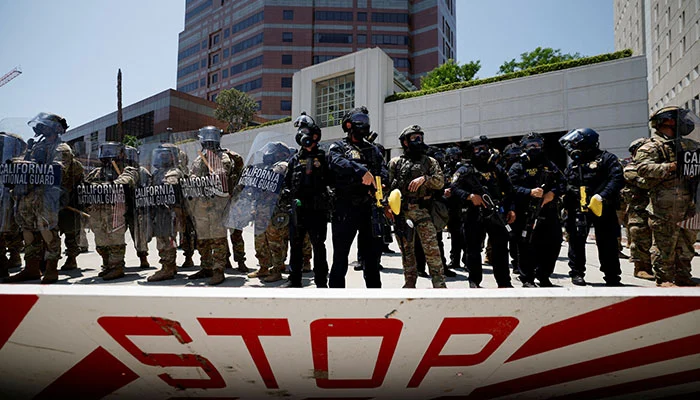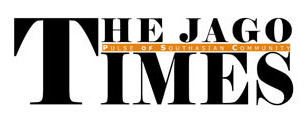California National Guard troops were deployed to the streets of Los Angeles on Sunday to help manage a third consecutive day of protests ignited by President Donald Trump’s immigration enforcement policies. The state’s Democratic governor, Gavin Newsom, however, declared the deployment unlawful. National Guard personnel were positioned around federal government buildings as police and demonstrators clashed in separate protests concerning federal immigration raids across Los Angeles.
The Los Angeles Police Department designated several rallies as “unlawful assemblies,” alleging that some protesters threw concrete, bottles, and other projectiles at officers. Video footage also showed several self-driving cars from Alphabet’s Waymo being set ablaze on a downtown street Sunday evening. “Arrests are being initiated,” the police department stated in a social media post. Los Angeles police deployed officers on horseback in an attempt to control the crowds.
Demonstrators reportedly shouted “shame on you” at police, with some appearing to throw objects, according to video evidence. A group of protesters blocked the 101 Freeway, a major artery in downtown Los Angeles. Various groups of protesters, many carrying Mexican flags and signs condemning US immigration authorities, gathered at multiple locations throughout the city. The Los Angeles chapter of the Party for Socialism and Liberation organized speakers for an afternoon rally outside City Hall.
California Governor Gavin Newsom announced that he had formally requested the Trump administration withdraw its order to deploy 2,000 National Guard troops in Los Angeles County, deeming it an unlawful act. Newsom accused Trump of attempting to manufacture a crisis and infringing upon California’s state sovereignty. “These are the acts of a dictator, not a President,” he posted on X.
The White House disputed Newsom’s characterization, issuing a statement that “everyone saw the chaos, violence and lawlessness.” Earlier, video showed approximately a dozen National Guard members, alongside Department of Homeland Security personnel, pushing back a group of demonstrators who had gathered outside a federal building in downtown Los Angeles. US Northern Command confirmed that 300 members of the California National Guard had been deployed to three areas within Los Angeles, with their mission limited to protecting federal personnel and property.
In a social media post on Sunday, Trump labeled the demonstrators “violent, insurrectionist mobs” and declared he was directing his cabinet officers “to take all such action necessary” to halt what he termed “riots.” Speaking to reporters in New Jersey, he threatened violence against demonstrators who might spit on police or National Guard troops, stating, “they spit, we hit,” though he did not cite specific incidents. “If we see danger to our country and to our citizens, it will be very, very strong in terms of law and order,” Trump added.
The FBI offered a $50,000 reward for information leading to the arrest of a suspect accused of throwing rocks at police vehicles in Paramount, which resulted in injury to a federal officer. Despite Trump’s strong rhetoric regarding the demonstrations, he has not invoked the Insurrection Act, an 1807 law that empowers a president to deploy the US military to suppress civil disorder. When asked on Sunday if he was considering invoking the law, he responded, “it depends on whether or not there’s an insurrection.”
‘Prepared to Mobilize Active-Duty Troops’
Defense Secretary Pete Hegseth warned that the Pentagon was prepared to mobilize active-duty troops “if violence continues” in Los Angeles, noting that Marines at nearby Camp Pendleton were “on high alert.” US Northern Command has indicated that approximately 500 Marines were prepared for deployment if ordered.
Los Angeles Mayor Karen Bass attributed the escalating tensions to the Trump administration’s decision to deploy the National Guard but also condemned protesters who resorted to violence. “I don’t want people to fall into the chaos that I believe is being created by the administration completely unnecessarily,” Bass told reporters at a press conference.
Vanessa Cárdenas, head of the immigration advocacy group America’s Voice, accused the Trump administration of “trumping up an excuse to abuse power, and deliberately stoke and force confrontations around immigration.” Homeland Security Secretary Kristi Noem told CBS’ “Face the Nation” on Sunday that the National Guard would ensure safety around buildings for both peaceful protesters and law enforcement.
Trump has pledged to deport a record number of undocumented individuals and to secure the US-Mexico border, setting a goal for ICE to apprehend at least 3,000 migrants daily. Census data suggests that a significant portion of the population in Democratic-led Los Angeles is Hispanic and foreign-born. However, these sweeping enforcement measures have also impacted individuals legally residing in the country, including some with permanent residency, leading to legal challenges.
Mexican President Claudia Sheinbaum on Sunday criticized the US government over the immigration raids and the deployment of the National Guard. “We do not agree with this way of addressing the immigration issue,” Sheinbaum, who has sought to foster a positive relationship with Trump, stated at a public event. “The phenomenon will not be addressed with raids or violence. It will be by sitting down and working on comprehensive reform.”
Legal Grounds of Deployment
Trump’s justification for the National Guard deployment cited a provision of Title 10 of the US Code concerning the Armed Forces. However, Title 10 also stipulates that “orders for these purposes shall be issued through the governors of the states.” It was not immediately clear if the President possessed the legal authority to deploy the National Guard without Governor Newsom’s explicit order.
Title 10 permits federal deployment of the National Guard if there is “a rebellion or danger of a rebellion against the authority of the Government of the United States.” Such troops are only authorized to engage in limited activities and are not permitted to undertake ordinary law enforcement functions. Trump’s memo specifies that the troops will “temporarily protect ICE and other United States government personnel who are performing Federal functions, including the enforcement of Federal law, and to protect federal property, at locations where protests against these functions are occurring or are likely to occur.”



